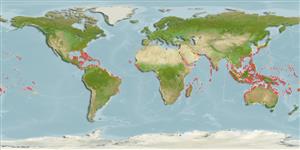Ακτινοπτερύγιοι >
Beloniformes (Needle fishes) >
Belonidae (Needlefishes)
Etymology: Tylosurus: Greek, tylos = callus + Greek, oura = tail (Ref. 45335).
Περιβάλλον / Κλίμα / Εύρος
Οικολογία
; Θαλασσινό(ά) Υφαλόφιλο(α); ωκεανόδρομο(ς) (Ref. 51243); εύρος βάθους 0 - 13 m (Ref. 58302). Tropical; 26°C - 29°C (Ref. 4959), preferred 28°C (Ref. 107945); 21°N - 1°N
Indo-West Pacific: Red Sea and South Africa (Ref. 5317) and Persian Gulf (Ref. 68964) to French Polynesia (Ref. 6784), north to Japan (Ref. 559), south to New South Wales, Australia (Ref. 33390). Replaced by Tylosurus crocodilus fodiator in the eastern Pacific. Western Atlantic: New Jersey, USA to Brazil (Ref. 7251). Eastern Atlantic: Fernando Poo, Cameroon, Liberia, and Ascension Island (Ref. 5757); from Senegal and Guinea (Ref. 28587); and Cape Verde (Ref. 27000). Recorded from the Mediterranean Sea (Ref. 83387).
Μέγεθος / Βάρος / Age
Maturity: Lm ? range ? - ? cm
Max length : 150 cm TL αρσενικό/απροσδιόριστο; (Ref. 30573); common length : 90.0 cm SL αρσενικό/απροσδιόριστο; (Ref. 9682); μεγ. δημοσιευμένο βάρος: 6.4 kg (Ref. 40637)
Ραχιαίες άκανθες (συνολικά): 0; Μαλακές ραχιαίες ακτίνες (συνολικά): 21-23; Εδρικές άκανθες 0; Μαλακές εδρικές ακτίνες: 18 - 22; Σπόνδυλοι: 80 - 86. Diagnosis: body elongate; upper and lower jaws extremely long, forming a stout beak armed with very sharp teeth; gill rakers absent (Ref. 57228, 90102). Nostrils in depression before eyes (nasal pit); pelvic fins abdominal; 21-23 dorsal-fin rays; anal fin long, 5.5-8.0 times in body length; small, black lateral keel on either sides of caudal peduncle; caudal fin deeply forked (Ref. 57228).
A pelagic species (Ref. 26340) found over lagoon and seaward reefs. Solitary or in small groups. Feeds on fishes (Ref. 11889). Oviparous (Ref. 205). Eggs may be found attached to objects in the water by tendrils on the egg's surface (Ref. 205). Feared by fishers because they can cause puncture wounds with their sharp snouts when jumping out of the water, e.g. when alarmed or attracted to lights at night. Although sold fresh and considered a good food fish, its market is limited due to the green-colored flesh (Ref. 5217). Widespread in tropical Indo-Pacific, divisible in two subspecies (Ref 90102).
Life cycle and mating behavior
Γεννητική Ωρίμανση | Αναπαραγωγή | Γεννοβολία | Αβγά | Γονιμότητα | Προνύμφες
Randall, J.E., G.R. Allen and R.C. Steene, 1990. Fishes of the Great Barrier Reef and Coral Sea. University of Hawaii Press, Honolulu, Hawaii. 506 p. (Ref. 2334)
IUCN Red List Status (Ref. 115185)
CITES (Ref. 94142)
Not Evaluated
Threat to humans
Traumatogenic (Ref. 4690)
Human uses
αλιεία: Εμπορικό(ά); αλιεία αναψυχής: ναί
Περισσότερες πληροφορίες
ΑναφορέςΥδατοκαλλιέργειεςΠροφίλ υδατοκαλλιέργειαςΣτελέχοιΓενετικήΣυχνότητες αλληλόμορφωνΚληρονομικότηταΑσθένειεςΜεταποίησηMass conversion
Εργαλεία
Special reports
Download XML
Διαδικτυακές πηγές
